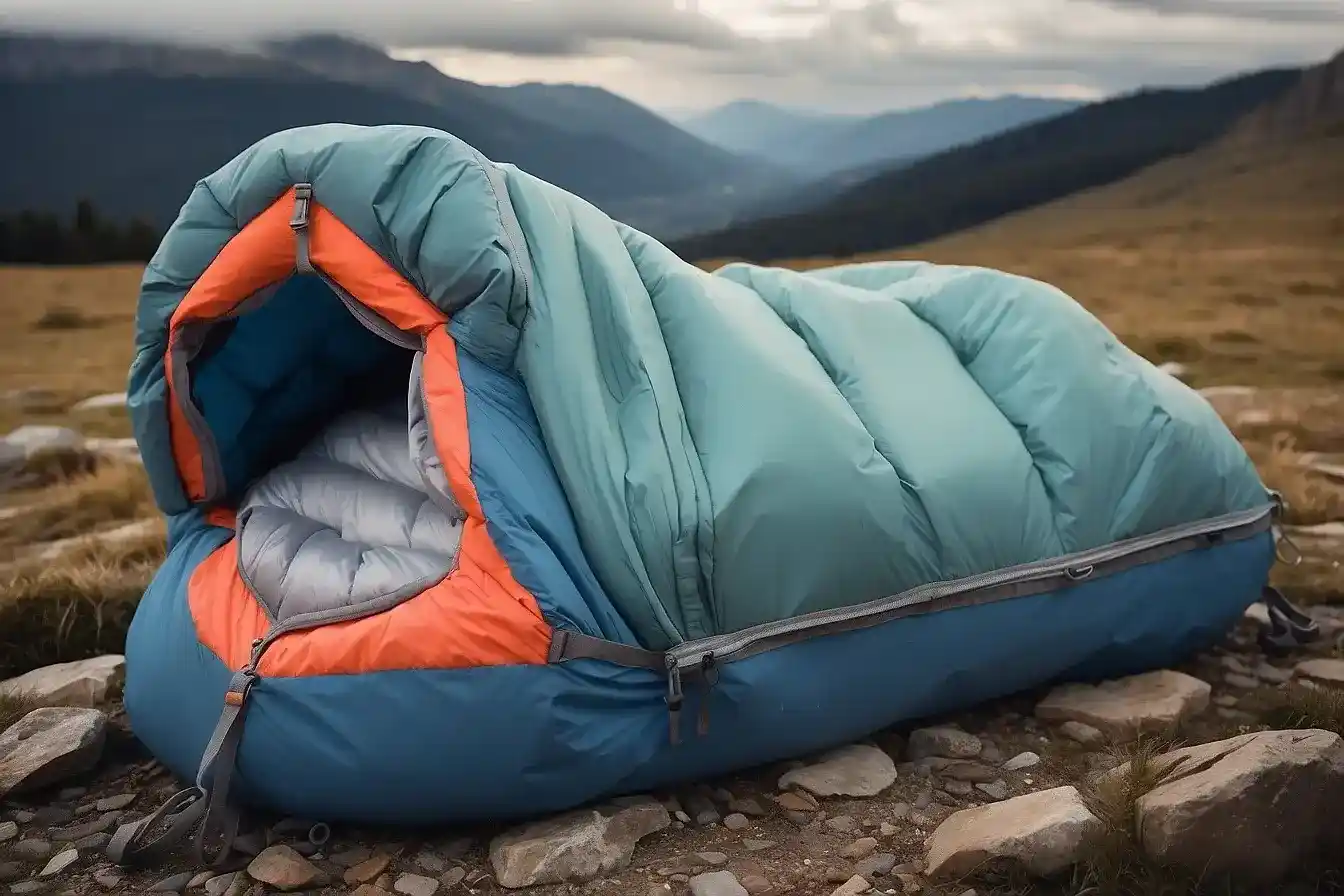Table of Contents
ToggleI. Introduction -kids sleeping bag
When planning a camping trip or any outdoor adventure with kids, ensuring their comfort and safety is a top priority. One of the essential items for a child’s camping gear is a well-fitted sleeping bag. Choosing the right size kids sleeping bags is crucial for providing a cozy and enjoyable camping experience.
The introduction sets the stage for the importance of selecting the appropriate kids sleeping bag for children. It highlights how the right sleeping bag can significantly impact a child’s comfort level, quality of sleep, and overall camping experience. The introductory section also emphasizes the significance of safety considerations in choosing the correct size.
Parents and caregivers need to understand that a kids sleeping bag that is too large may not provide sufficient insulation, leading to discomfort and cold spots. Conversely, a sleeping bag that is too small can be restrictive, making it difficult for the child to move comfortably during sleep.

II. Consider the Child’s Height and Age
When selecting a kids sleeping bag, one of the fundamental factors to take into account is the child’s height and age. A properly fitting kids sleeping bag ensures optimal comfort and warmth, allowing the child to sleep soundly during their camping adventures.
1. Choosing a kids sleeping bag appropriate for their height: It is essential to choose a kids sleeping bag that matches the child’s height. Sleeping bags come in various lengths, typically specified in inches or centimeters. Ideally, the sleeping bag should be long enough to accommodate the child from head to toe without leaving excessive empty space at the bottom.
When lying inside the bag, the child’s feet should comfortably rest at the foot of the bag without pushing against the end.
2. Age considerations for ensuring a good fit: While height is a primary consideration, the child’s age can also play a role in determining the right sleeping bag size. Younger children may require smaller bags with less space to minimize heat loss and create a cozy environment. Older children, on the other hand, may benefit from slightly larger bags that allow for growth and movement during sleep.
It is worth noting that some kids sleeping bags are designed with adjustable features to accommodate growth spurts. These bags can be lengthened or shortened, providing an extended period of use as the child grows. Such adjustable kids sleeping bags can be particularly beneficial for families looking to invest in gear that will last for several years.

III. Evaluate the Bag’s Length and Width
When selecting a kids sleeping bag, it is crucial to evaluate both the bag’s length and width to ensure a proper fit and maximum comfort for the child during outdoor excursions.
1. Ensuring the bag is long enough for the child to stretch comfortably: The length of the kids sleeping bag is a critical consideration. The bag should be long enough to accommodate the child’s height while providing enough space to stretch out comfortably.
A bag that is too short may leave the child feeling cramped and uncomfortable, leading to a restless night’s sleep. On the other hand, a bag that is excessively long may result in heat loss as the child’s body struggles to warm the extra empty space.
2. Avoid overly wide bags that may lead to cold spots: While width is essential for comfort, an overly wide sleeping bag can create cold spots inside. Excess space allows air to circulate, potentially leading to a drop in temperature. To avoid this issue, choose a sleeping bag with a width that is snug enough to prevent cold air from entering but not too tight to restrict movement during sleep.
kids Sleeping bag dimensions are typically provided by manufacturers, allowing parents to compare different options to find the most suitable fit for their child’s size. Considering the child’s height, age, and body measurements will help ensure a comfortable fit, making camping experiences more enjoyable for young adventurers.
IV. Look for Adjustable Features
When choosing a kids sleeping bag, considering models with adjustable features can offer added flexibility and convenience, especially as children grow and their camping needs change. Adjustable sleeping bags can accommodate different body sizes and provide a more personalized fit for young adventurers.
1. Sleeping bags with adjustable length options: Some sleeping bags come with innovative designs that allow parents to adjust the length as the child grows. These bags may have extendable foot compartments that can be lengthened or shortened to match the child’s height. This feature ensures that the sleeping bag can be used for an extended period, making it a cost-effective and practical investment.
2. Bags with adjustable hoods and collars for a snug fit: Adjustable hoods and collars can help create a snug fit around the child’s head and neck, providing additional warmth and comfort during colder nights. These features are particularly useful for camping in chilly weather, as they help minimize heat loss and create a cozy sleeping environment.
Adjustable kids sleeping bags offer versatility, making them suitable for a range of camping conditions and environments. Whether camping during colder months or warmer seasons, the ability to customize the fit of the sleeping bag ensures the child’s comfort and enjoyment throughout the camping trip.

V. Check the Temperature Rating
The temperature rating of a kids sleeping bag is a crucial factor in ensuring the child’s comfort and safety during camping trips. Understanding the temperature rating system and choosing the appropriate rating based on expected weather conditions is essential for providing an enjoyable sleeping experience.
1. Understanding the bag’s temperature rating system: kids Sleeping bags are typically assigned a temperature rating that indicates the lowest temperature at which the bag can keep the user warm. The rating is expressed in degrees Fahrenheit or Celsius.
2. Choosing the appropriate rating based on expected weather conditions: When selecting a kids sleeping bag, it is essential to consider the climate and temperature range of the camping destination. If camping in colder regions or during the winter season, a sleeping bag with a lower temperature rating is recommended to provide sufficient insulation and warmth.
Conversely, for warmer climates or summer camping, a kids sleeping bag with a higher temperature rating may be more suitable to prevent overheating.
It is crucial to note that while temperature ratings offer guidance, individual preferences and tolerance to cold can vary. Some children may naturally feel warmer or colder than others at the same temperature. Additionally, factors such as clothing worn inside the bag and the use of insulating sleeping pads can influence the bag’s actual performance.
VI. Consider the Insulation Type and Fill
The insulation type and fill of a kids sleeping bag play a significant role in determining its warmth, weight, and performance in different weather conditions. Understanding the various insulation options and their characteristics can help parents and caregivers select a sleeping bag that best suits their child’s camping needs.
1. Down, synthetic, or hybrid insulation options:
a. Down Insulation: Down is a natural insulating material derived from the plumage of ducks or geese. It is highly efficient at trapping warmth and providing excellent insulation.
Down sleeping bags are known for their exceptional warmth-to-weight ratio, making them lightweight and compressible. However, down is vulnerable to moisture and loses its insulating properties when wet.
b. Synthetic Insulation: Synthetic fill is made of polyester fibers designed to mimic the insulating properties of down. Synthetic sleeping bags are generally more affordable than down bags and perform better in wet conditions since they retain their warmth even when damp. While they may be slightly heavier than down bags, they are an excellent option for camping in humid or rainy environments.
C. Hybrid Insulation: Some kids sleeping bags combine both down and synthetic fill to harness the advantages of each material. Hybrid bags aim to provide the best of both worlds—excellent warmth-to-weight ratio from down and moisture resistance from synthetic fill.
2. Factors to consider when selecting the right insulation for the child:
a. Climate and Weather Conditions: Consider the typical weather conditions of the camping destination. If camping in wet or humid environments, a synthetic or hybrid bag may be more suitable to ensure consistent insulation.
b. Weight and Packability: If the child will be carrying their own gear during backpacking trips, the weight and compressibility of the sleeping bag are essential considerations. Downbags are typically lighter and more packable than synthetic options.
c. Allergies and Sensitivities: Some children may have allergies or sensitivities to downfill. In such cases, synthetic fill provides a hypoallergenic alternative.
d. Budget: Budget considerations can also influence the choice of insulation type, as sleeping bags tend to be more expensive than synthetic options.

VII. Check for Compressibility and Weight
When choosing a kids sleeping bag, considering its compressibility and weight is vital, especially for camping trips that involve hiking or backpacking.
A compact and lightweight sleeping bag can significantly impact the child’s comfort and mobility during outdoor adventures.
1. Assessing the kids bag’s portability and ease of packing: Compressibility refers to how easily the sleeping bag can be packed down into a smaller size. Sleeping bags with high compressibility can be compressed into a stuff sack, reducing their volume for convenient storage and transportation. Compact sleeping bags are particularly advantageous for backpacking trips, where space is limited and minimizing bulk is essential.
2. Selecting a lightweight sleeping bag suitable for kids’ outdoor adventures: A lightweight sleeping bag can significantly improve a child’s mobility and overall camping experience. Carrying heavy gear can be tiring and cumbersome, especially for young adventurers.
A lightweight kids sleeping bag allows the child to move freely during the day and helps prevent fatigue, ensuring they have the energy to enjoy the camping activities fully.
Sleeping bags with down insulation are often more compressible and lighter than synthetic-filled options, making them a popular choice for backpacking and hiking trips. However, it is essential to strike a balance between compressibility, weight, and the desired temperature rating to ensure the child stays warm and comfortable throughout the journey
VIII. Test the Zippers and Openings
When selecting a kids sleeping bag, it is essential to thoroughly test the zippers and openings to ensure they function smoothly and securely. The zipper is a critical component of the sleeping bag, allowing the child to easily enter and exit the bag and providing ventilation options during warmer nights.
1. Ensuring smooth and snag-free zippers for easy use: Parents and caregivers should check the zippers to ensure they glide smoothly along the bag’s length without catching or snagging on the fabric. Snagging zippers can be frustrating for children and may lead to damage if forced open or closed. Opt for sleeping bags with high-quality zippers and well-constructed zipper tracks to avoid these issues.
2. Examining dual-zipper options for ventilation and flexibility: Some sleeping bags come with dual zippers that allow the child to open the bag from both the top and bottom. Dual-zipper options provide added ventilation during warmer nights, enabling the child to regulate their body temperature.
Moreover, the dual-zipper design allows for easy adjustments, such as folding down the top portion of the bag to create a cozy blanket or opening the bottom for additional foot space.
Parents can demonstrate to the child how to operate the zippers and ensure they feel comfortable using them independently. Easy-to-use zippers enhance the child’s autonomy and enable them to manage their bags.
Additionally, parents should check for zipper draft tubes, which are insulated baffles that run alongside the zipper to prevent cold air from seeping through. The inclusion of draft tubes enhances the bag’s insulation and prevents heat loss, particularly during chilly nights.

X. Conclusion
Selecting the right kids sleeping bag is a critical decision that directly impacts a child’s comfort, safety, and enjoyment during camping adventures. By considering essential factors such as the child’s height and age, evaluating the bag’s length and width, and checking for adjustable features, parents and guardians can ensure a well-fitted and cozy sleeping bag.
Furthermore, understanding the bag’s temperature rating and carefully choosing the insulation type and fill based on expected weather conditions contribute to maintaining an optimal sleeping environment for the child. Additionally, checking for compressibility and weight ensures a portable and lightweight sleeping bag, is ideal for backpacking and hiking trips.
Examining the zippers and openings for smooth operation and flexibility enhances the child’s autonomy and convenience during camping trips. Finally, reviewing user feedback and seeking recommendations from experienced camping enthusiasts provides valuable insights and guidance in making the best choice.
FAQs
1. Q: What is the best sleeping bag size for my child?
A: The best sleeping bag size for your child depends on their height and age. It is essential to choose a bag that allows the child to stretch comfortably without leaving excessive empty space at the bottom. Refer to the sleeping bag’s dimensions and consider adjustable options to accommodate growth.
2. Q: What is the temperature rating of a sleeping bag, and how do I choose the right one?
A: The temperature rating indicates the lowest temperature at which the bag can keep the user warm. Choose a temperature rating suitable for the expected weather conditions of your camping destination. Consider factors like the child’s sensitivity to cold and the use of additional insulation, such as sleeping pads and clothing.
3. Q: Which insulation type is better, down or synthetic?
A: Both down and synthetic insulation have their advantages. Down offers excellent warmth-to-weight ratio but can lose insulation properties when wet. Choose based on climate, budget, and the child’s specific needs.
4. Q: How important is the weight and compressibility of the sleeping bag?
A: Weight and compressibility are crucial for backpacking and hiking trips where space and weight are limited. A lightweight and compact sleeping bag make transportation easier and provide the child with more freedom of movement during the day.
5. Q: Are there sleeping bags with adjustable features for growing kids?
A: Yes, some sleeping bags come with adjustable length options to accommodate a child’s growth. Look for models with extendable foot compartments or hybrid designs that offer versatility for extended use.
6. Q: Can I trust user reviews when choosing a sleeping bag?
A: User reviews can be valuable sources of information. Reading reviews from other parents and experienced campers provides insights into the performance and durability of different sleeping bag models. Consider patterns in reviews to gauge overall satisfaction.
7. Q: How do I ensure smooth zipper operation in a sleeping bag?
A: Check for high-quality zippers and well-constructed zipper tracks. Test the zippers to ensure they glide smoothly without snagging. Dual-zipper options provide added ventilation and flexibility.
8. Q: What safety features should I consider in a kids sleeping bag?
A: Look for sleeping bags with draft tubes alongside the zippers to prevent cold air from entering. Ensure the bag meets safety standards and has flame-resistant materials.
9. Q: How can I maintain and clean a kids sleeping bag?
A: Follow the manufacturer’s care instructions. Use a gentle detergent and avoid washing too frequently. Air-dry the sleeping bag thoroughly before storage.
10. Q: Can my child use the same sleeping bag for different seasons?
A: Yes, some sleeping bags have temperature versatility and can be used in various seasons. Consider using additional blankets or liners for colder nights.







